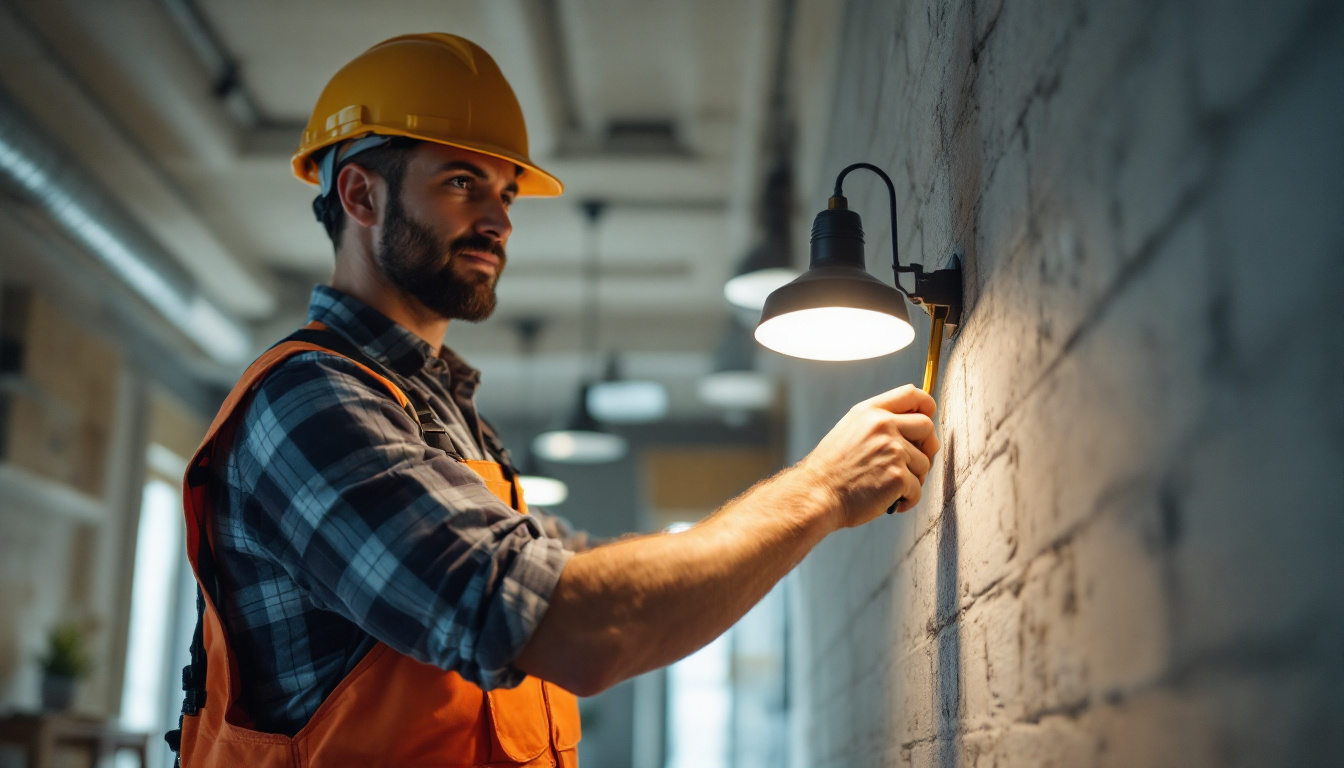
In the realm of electrical work, particularly lighting installation, wire connections are a crucial aspect that can significantly influence the safety, efficiency, and longevity of a project. Mastering the art of wire connections is not just about technical skill; it also requires a deep understanding of materials, techniques, and best practices. This article delves into the essentials of wire connections, providing lighting contractors with the knowledge needed to excel in their craft.
Before diving into the intricacies of wire connections, it’s essential to have a solid grasp of the types of wires available and their specifications. Different applications require different types of wires, and knowing which to use can make or break a lighting project. The choice of wire can significantly impact the performance and longevity of the electrical system, making it crucial for contractors to stay informed about the latest advancements in wire technology and materials.
Lighting contractors typically encounter several types of wires, including non-metallic sheathed cable (NM), armored cable (AC), and conduit wiring. NM cable, often referred to as Romex, is widely used for residential lighting due to its ease of installation and flexibility. This type of wire consists of two or more insulated conductors and a bare ground wire, all encased in a plastic sheath, making it an excellent choice for indoor applications where the risk of moisture is minimal. On the other hand, armored cable provides additional protection and is suitable for areas where physical damage might occur, such as in basements or garages where equipment may be moved frequently.
Conduit wiring, which involves running wires through metal or plastic tubing, is ideal for commercial applications or outdoor settings. This method not only protects the wires from environmental factors but also allows for easier upgrades and maintenance. Each type has its own advantages and disadvantages, and understanding these can help contractors choose the right wire for a specific job. For instance, while NM cable is lightweight and easy to work with, it may not be suitable for wet locations, whereas conduit wiring can be more labor-intensive but offers superior protection against the elements.
Wire gauge is another critical factor that lighting contractors must consider. The gauge of a wire determines its current-carrying capacity, known as ampacity. Using a wire with an inadequate gauge can lead to overheating and potential fire hazards. For most residential lighting applications, a 14 or 12-gauge wire is common, but larger installations may require heavier gauge wires. It’s important to note that the ampacity of a wire can also be affected by factors such as ambient temperature and the number of conductors bundled together, which can lead to derating and necessitate a larger gauge than initially anticipated.
Contractors should always consult the National Electrical Code (NEC) guidelines to ensure compliance with local regulations regarding wire gauge and ampacity. This knowledge not only enhances safety but also instills confidence in clients regarding the quality of work. Additionally, understanding the implications of voltage drop over long distances can also influence wire selection, as excessive voltage drop can lead to inefficient lighting and increased energy costs. By being well-versed in these technical specifications, contractors can provide tailored solutions that meet both safety standards and client expectations, ensuring a successful lighting project from start to finish.
Having the right tools is paramount for making effective wire connections. The right equipment not only streamlines the process but also ensures that connections are secure and reliable.
Wire cutters and strippers are indispensable tools for any lighting contractor. Wire cutters allow for clean cuts, while strippers enable the removal of insulation without damaging the wire itself. Investing in high-quality tools can make a significant difference in the ease and efficiency of making connections.
When selecting wire strippers, look for models with adjustable settings to accommodate various wire gauges. This versatility can save time and reduce frustration on the job site.
Connection tools such as wire nuts, crimp connectors, and terminal blocks are essential for creating secure and lasting connections. Wire nuts are commonly used for connecting multiple wires together, providing a simple and effective solution for splicing. Crimp connectors offer a more permanent solution, requiring a crimping tool to secure the connection.
Terminal blocks are particularly useful in more complex installations, allowing for organized and easily accessible connections. Understanding when and how to use each type of connector can enhance the quality of work and reduce the likelihood of future issues.
Even with the right tools and materials, the technique used in making wire connections is vital. Adhering to best practices can lead to safer and more reliable installations.
Before making any connections, it’s essential to prepare the wires properly. This includes stripping the insulation to the appropriate length, usually around half an inch, to ensure a solid connection. Additionally, the ends of the wires should be twisted together neatly to prevent any fraying or loose ends that could lead to shorts or failures.
When connecting multiple wires, it’s advisable to align them in the same direction. This alignment not only helps in making a secure connection but also reduces the chance of wires becoming tangled or dislodged later on.
Once the wires are prepared, the next step is to secure the connections. For wire nuts, it’s crucial to twist them on tightly, ensuring that the wires are fully engaged and that no bare wire is exposed. For crimp connectors, using the appropriate crimping tool is vital to achieving a strong connection.
After securing the connections, it’s a good practice to gently tug on the wires to ensure they are firmly attached. This quick check can prevent future issues that may arise from loose connections.
Safety should always be a top priority for lighting contractors. Understanding the risks associated with electrical work and taking appropriate precautions is essential to prevent accidents and injuries.
Wearing the right personal protective equipment is crucial when working with electrical systems. This includes safety goggles to protect the eyes from flying debris, gloves to prevent electrical shocks, and insulated tools to reduce the risk of accidental contact with live wires.
Additionally, contractors should ensure that the work area is well-lit and free from clutter to minimize the risk of trips and falls. A clean workspace not only enhances safety but also improves efficiency.
Familiarity with local electrical codes and regulations is essential for ensuring safety and compliance. These codes dictate how electrical installations should be performed and often include specific requirements for wire connections.
Contractors should regularly review updates to the NEC and any local amendments to stay informed about best practices and safety protocols. Adhering to these guidelines not only protects the contractor but also the clients and their properties.
For lighting contractors looking to elevate their skills, mastering advanced wire connection techniques can set them apart from the competition. These techniques often involve more complex installations but can lead to more efficient and reliable systems.
Junction boxes are an essential component in many lighting installations, providing a safe and organized way to connect multiple wires. They protect connections from damage and make it easier to access them for future maintenance or upgrades.
When using junction boxes, it’s important to ensure they are properly rated for the application and that they are installed in accessible locations. Additionally, all connections within the box should be secured and insulated to prevent short circuits.
As technology advances, smart lighting systems are becoming increasingly popular. These systems often require more intricate wiring and connections, including low-voltage wiring and integration with home automation systems.
Contractors should familiarize themselves with the specific requirements for smart lighting installations, including the types of wires and connectors needed. Understanding how to integrate these systems can provide clients with modern solutions that enhance convenience and energy efficiency.
Even the most experienced contractors can encounter issues with wire connections. Knowing how to troubleshoot common problems can save time and prevent costly mistakes.
Loose connections can lead to flickering lights or complete outages. If a lighting fixture is not functioning properly, the first step is to check all wire connections to ensure they are secure. Gently tugging on the wires can help identify any loose connections that may need to be re-secured.
Additionally, using a multimeter to test for continuity can help pinpoint issues in the circuit. This tool can quickly identify whether power is reaching the fixture or if there is a break in the wiring.
Overheating wires are a serious concern and can indicate a problem with the installation. If wires are excessively warm to the touch, it may be due to using an inadequate gauge or poor connections. In such cases, it’s crucial to immediately disconnect power and assess the situation.
Contractors should evaluate the entire circuit, checking for signs of damage or wear. Replacing wires with the appropriate gauge and ensuring all connections are secure can help mitigate this issue.
Mastering wire connections is an essential skill for lighting contractors, impacting not only the quality of work but also the safety and satisfaction of clients. By understanding wire types, employing the right tools, adhering to best practices, and staying informed about safety regulations, contractors can elevate their work to new heights.
As technology continues to evolve, embracing advanced techniques and troubleshooting methods will further enhance a contractor’s expertise. Ultimately, the mastery of wire connections is a journey that requires continuous learning and adaptation, ensuring that lighting contractors remain at the forefront of their field.
Now that you’re equipped with the knowledge to master wire connections, take your lighting projects to the next level with LumenWholesale. We provide contractors with the highest quality, spec-grade lighting products at unbeatable wholesale prices. Say goodbye to local distributor markups and hello to superior lighting that meets the highest industry standards. With our hassle-free bulk buying and free shipping, you can stock up on reliable, high-performance lighting without hidden fees or compromises. Elevate your craft with the perfect blend of quality, affordability, and convenience. Discover the best value in wholesale lighting by visiting LumenWholesale today.

Discover the essentials of commercial light strands in just five minutes with this comprehensive guide tailored for lighting contractors.

Discover how water-proof outside wire connectors play a crucial role in enhancing energy efficiency.

Discover how lighting contractors can effectively navigate the challenges of converting lumens to watts in modern lighting projects.

Discover the essential insights every lighting contractor needs about commercial LED street lights.